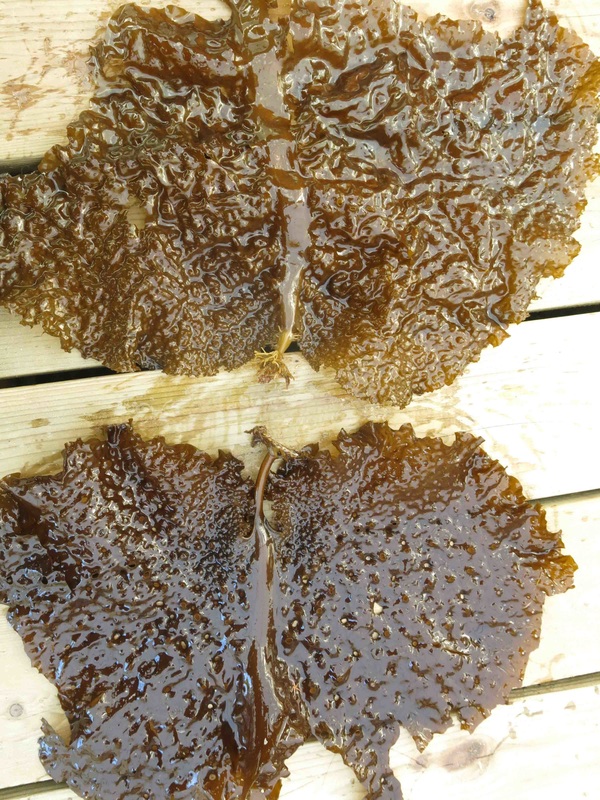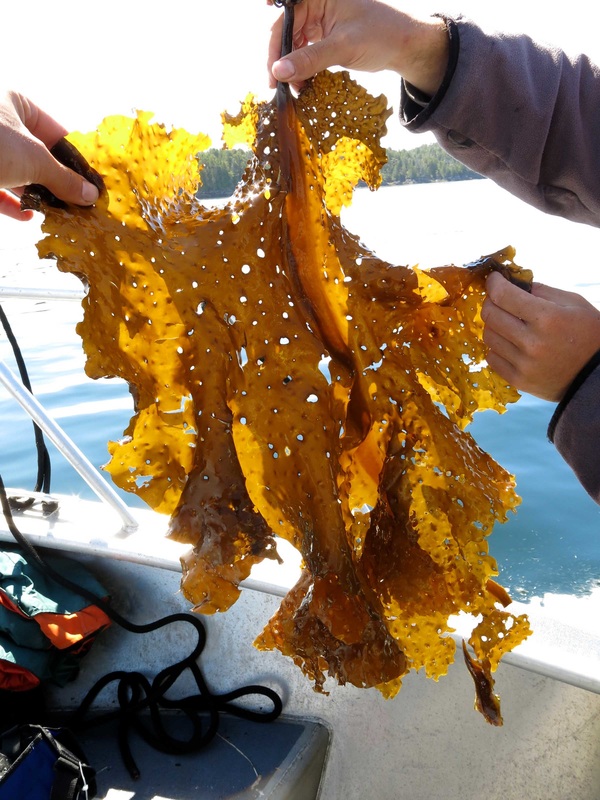Sieve kelp, sea colander kelp • Agarum clathratum
Left: sieve kelp (bottom) compared to fringed sieve kelp (top). The stipe of sieve kelp is rounded and has no projections; the stipe of the similar fringed sieve kelp is shorter, flattened, and bears tooth-like projections. Right: note the many small holes perforating the kelp. Photos by Jenn Burt.
Identification
Sieve kelp is a perennial brown alga with a large, stiff blade reaching 90 cm long and 50 cm wide. The distinctive blade has a wide midrib and is perforated by many small holes. Its smooth, cylindrical stipe can be up to 30 cm long and ends in a highly branched holdfast.
Habitat & Range
Sieve kelp grows on rock in the very low intertidal and subtidal (to 20 m) of semi-protected shorelines. Its range extends from northern Washington to the Bering Sea and Arctic Ocean, and eastward into the western North Pacific (Russia, Japan, and Korea). It is also found in the North Atlantic.
Similar Species
Sieve kelp (Agarum clathratum) is very similar to fringed sieve kelp (Agarum fimbriatum). The latter has a short, flattened stipe with projections; in contrast, the stipe of sieve kelp is not flattened, does not bear projections, and is often much longer.
Intriguing Info
Sieve kelp can live for more than 5 years. Established populations can persist even in areas that are heavily grazed by sea urchins, as urchins appear to avoid this species.
Sieve kelp is a perennial brown alga with a large, stiff blade reaching 90 cm long and 50 cm wide. The distinctive blade has a wide midrib and is perforated by many small holes. Its smooth, cylindrical stipe can be up to 30 cm long and ends in a highly branched holdfast.
Habitat & Range
Sieve kelp grows on rock in the very low intertidal and subtidal (to 20 m) of semi-protected shorelines. Its range extends from northern Washington to the Bering Sea and Arctic Ocean, and eastward into the western North Pacific (Russia, Japan, and Korea). It is also found in the North Atlantic.
Similar Species
Sieve kelp (Agarum clathratum) is very similar to fringed sieve kelp (Agarum fimbriatum). The latter has a short, flattened stipe with projections; in contrast, the stipe of sieve kelp is not flattened, does not bear projections, and is often much longer.
Intriguing Info
Sieve kelp can live for more than 5 years. Established populations can persist even in areas that are heavily grazed by sea urchins, as urchins appear to avoid this species.
References
Guiry, M.D. & Guiry, G.M. (2015). Agarum clathratum Dumortier. AlgaeBase. National University of Ireland, Galway. Accessed 16/06/2015.
Lamb, A., and Hanby, B. (2005). Marine Life of the Pacific Northwest [electronic version]. Madeira Park, BC: Harbour Publishing.
Lindberg, M. and Lindstrom, S. (2010). Agarum clathratum Sieve Kelp. Seaweeds of Alaska. Accessed 16/06/2015.
O'Clair, R. and Lindsrom, S. Agarum clathratum Dumortier. In Klinkenberg, Brian. (Ed.). E-Flora BC: Electronic Atlas of the Plants of British Columbia. Lab for Advanced Spatial Analysis, Department of Geography, University of British Columbia, Vancouver. Accessed 16/06/2015.
Authors and editors of page
Kelly Fretwell and Brian Starzomski (2015).
Guiry, M.D. & Guiry, G.M. (2015). Agarum clathratum Dumortier. AlgaeBase. National University of Ireland, Galway. Accessed 16/06/2015.
Lamb, A., and Hanby, B. (2005). Marine Life of the Pacific Northwest [electronic version]. Madeira Park, BC: Harbour Publishing.
Lindberg, M. and Lindstrom, S. (2010). Agarum clathratum Sieve Kelp. Seaweeds of Alaska. Accessed 16/06/2015.
O'Clair, R. and Lindsrom, S. Agarum clathratum Dumortier. In Klinkenberg, Brian. (Ed.). E-Flora BC: Electronic Atlas of the Plants of British Columbia. Lab for Advanced Spatial Analysis, Department of Geography, University of British Columbia, Vancouver. Accessed 16/06/2015.
Authors and editors of page
Kelly Fretwell and Brian Starzomski (2015).





